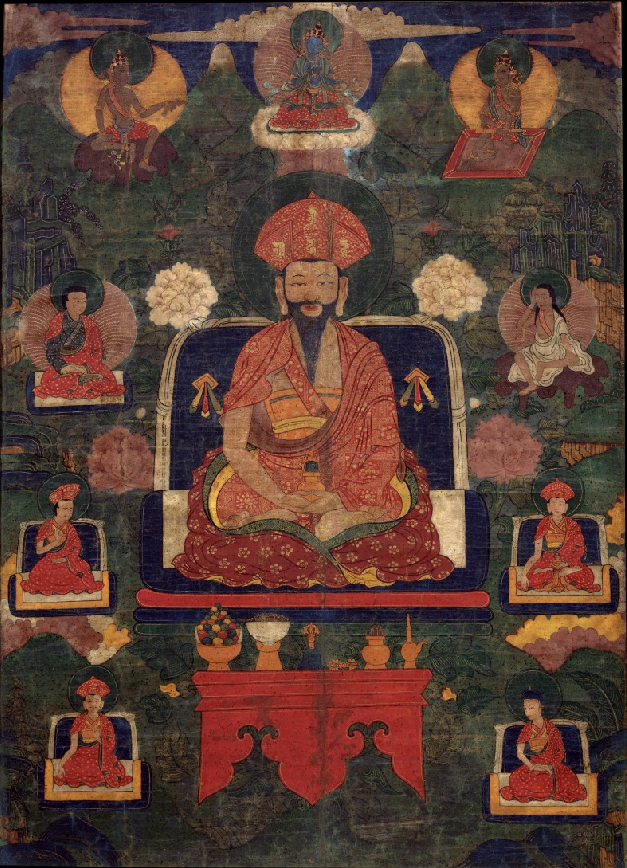BHUTAN
Travelog
Zhabdrung Ngawang Namgyel: The Founding Father of Bhutan

Zhabdrung Ngawang Namgyel is widely regarded as the founding father of Bhutan, whose influence still resonates across the nation’s spiritual, cultural, and political landscapes. Born in the late 16th century (1594), he arrived in Bhutan in 1616 and undertook the monumental task of unifying its warring valleys. Through a combination of religious reform, strategic governance, and military prowess, he laid the foundations for the Bhutanese state and established the Drukpa Kagyu school as the dominant Buddhist tradition. This article explores his extraordinary journey—from his early life and education to his enduring legacy in shaping modern Bhutan.

Image credit: himalayanart.org
Early Life and Education
Zhabdrung Ngawang Namgyel was born in Tibet in 1594 as the recognised reincarnation of Künkhyen Pema Karpo, a prominent master of the Drukpa Kagyu lineage. He belonged to the powerful Ralung Monastery in southern Tibet, where his upbringing was steeped in the teachings of Tibetan Buddhism and spiritual leadership. His early education at Drepung Monastery, one of Tibet’s premier centres of learning, was pivotal in shaping his scholarly and doctrinal foundation. Under the guidance of accomplished masters, he gained deep insight into Buddhist philosophy and monastic discipline (Vinaya), which would later inform his approach to both governance and religious life in Bhutan.
A Spiritual Refuge and Vision for Unification
Facing threats to his legitimacy from rival religious factions in Tibet, Zhabdrung left for Bhutan in 1616. He was 22 years old. Bhutan at the time was politically fragmented, with competing regional leaders and sects. Zhabdrung envisioned not only a unified Bhutanese state but one anchored in a shared spiritual identity. He quickly gained support among local communities and lamas, using both diplomacy and strategic military campaigns to consolidate power.
Military Strategy and National Unity
Zhabdrung’s military leadership was instrumental in uniting Bhutan's disparate regions. One notable victory was against Tibetan invaders during the 1630s, particularly at the Battle of Simtokha, which cemented his control over the western valleys. His use of fortresses, or dzongs, as both administrative and religious centres was revolutionary. The construction of iconic dzongs such as Simtokha Dzong (built in 1629) and Punakha Dzong (built in 1637) was central to his unification strategy. These structures served as enduring symbols of authority and harmony between the temporal and spiritual.
Establishing the Drukpa Kagyu Tradition in Bhutan
Zhabdrung formally established the Drukpa Kagyu lineage as the state religion of Bhutan, effectively distinguishing Bhutanese Buddhism from its Tibetan counterpart. By doing so, he rooted the country’s spiritual identity in a uniquely Bhutanese interpretation of the Drukpa tradition. He instituted key practices such as the annual tshechus (religious festivals) and formalised monastic systems, ensuring Buddhism remained closely tied to national governance and daily life. This spiritual legacy helped unify Bhutanese society beyond political lines and remains a defining characteristic of Bhutan today.
Cultural and Religious Contributions
Beyond unification, Zhabdrung championed religious harmony and cultural pride. He promoted compassion, mindfulness, and communal rituals, reinforcing a shared sense of purpose across the valleys. His policies supported the construction of monasteries, the standardisation of rituals, and the nurturing of a Bhutanese Buddhist aesthetic. Punakha Dzong, where he later passed away in 1651, continues to be a sacred site and centre of national memory.

Legacy and Modern Influence
Zhabdrung Ngawang Namgyel's legacy is deeply ingrained in Bhutanese identity. He introduced the concept of dual governance (chhoe-sid), where temporal and religious authority would coexist—a framework that underpins Bhutan’s governance even today. Many scholars see his philosophies reflected in Bhutan’s modern Gross National Happiness policy, which prioritises spiritual well-being alongside material development. His teachings are also integrated into school curricula, public ceremonies, and national values that prioritise compassion, humility, and unity.
National Commemorations
Zhabdrung is venerated through annual commemorations such as Zhabdrung Kuchoe, held on the 10th day of the third Bhutanese month, marking the anniversary of his passing. During this occasion, Bhutanese gather at dzongs and monasteries to offer butter lamps, recite prayers, and perform traditional dances in his honour. Another significant observance is Drukpa Tshe Zhi (Drukpa Fourth Day), celebrating his arrival in Bhutan, often marked with public teachings and community gatherings. These events not only pay homage to his life but also serve to strengthen national identity and intergenerational reverence for Bhutan’s spiritual roots.
Zhabdrung Ngawang Namgyel was far more than a religious reformer—he was a visionary who forged Bhutan’s national consciousness. Through strategic governance, spiritual leadership, and cultural innovation, he created a legacy that continues to define the Bhutanese way of life. His profound influence on the country’s governance, religion, and cultural traditions endures, making him one of the most revered figures in Bhutanese history.
Follow Druk Asia on social media for inspiring travel stories, breathtaking photos, and the latest updates from Bhutan.
Ready to Experience the Magic of Bhutan?
Fill in the form below and the friendly Bhutan Travel Specialist team will get back to you with expert advice, itinerary ideas, and everything you need to know. No obligations, just warm guidance from those who know Bhutan best.
Thank you for your message!
Hang tight—one of our friendly Bhutan Travel Specialists from Druk Asia will be reaching out soon with expert tips, insider advice, and exciting itinerary ideas to help you plan the adventure of a lifetime!
Discover
Breathtaking
Bhutan.
Thank you for subscribing!
You have successfully subscribed to our newsletter.




